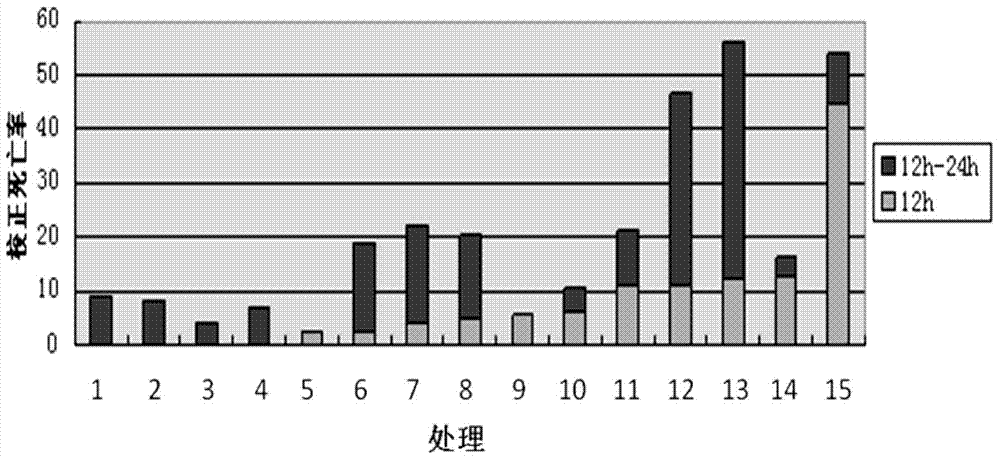Method for preventing horticultural crop mites by amblyseius pseudolongispinosus
A technique for horticulture and amblyseius pseudolongisi is applied in the field of biological control of pests by using the amblyseius pseudolongisii mite, and can solve the problems of perishable or dry leaves, difficult packaging of leaves, affecting the yield and quality and safety of agricultural products, and the like, Achieving strong control effect and long lasting effect
- Summary
- Abstract
- Description
- Claims
- Application Information
AI Technical Summary
Problems solved by technology
Method used
Image
Examples
Embodiment 1
[0031] Example 1 Study on the Selectivity of Amblyseius pseudopilanoides to Pesticides
[0032] 1. Test mite source The test source is Amblyseius (Amblyseius) pseudolongispinosus Xin, Lang et Ke, which was purchased from Beijing Kuoye Tianyuan Biotechnology Co., Ltd. and placed at a temperature of 25°C and a relative humidity of 80%. 1. Photoperiod 16L: Tetranychus cinnabarinus raised on kidney beans was used as feed in the 8D artificial climate box, and the feed was changed every day, and the inside of the tray was kept clean. For the production method of Amblyseius pseudolancei in the examples of the present invention, refer to Chinese patent CN101642080B.
[0033] 2. Instruments and materials Intelligent artificial climate box (manufactured by Ningbo Jiangnan Instrument Factory, model RXZ), stereo microscope (Motic, SMZ168), sprayer, tweezers, petri dish, sponge, filter paper, marker pen, small brush, etc.
[0034] 3. Test agent acaricide: 73% dexamethorphan EC (Chemtura A...
Embodiment 2 2
[0051] Example 2 Tetranychus urticae is measured for resistance to fifteen conventional insecticides
[0052] 1. Source of tested insects
[0053] Sensitive strain: adults of Tetranychus urticae Koch, which are obtained from breeding in the laboratory of Beijing Plant Protection Station under the condition of no pesticide application all year round.
[0054] Resistant strain: adults of Tetranychus urticae Koch, the source of which was collected in a solar greenhouse in Changping District, Beijing.
[0055] 2. Test materials
[0056] Artificial intelligence climate box (manufactured by Ningbo Jiangnan Instrument Factory, model RXZ), stereo microscope (Motic, SMZ168), tweezers, filter paper, petri dish, sprayer, sponge, marker pen, small brush.
[0057] 3. Drugs to be tested
[0058] Table 215 test drug information table
[0059]
[0060]
[0061] 4. Test method
[0062] 4.1 Reaction vessel setup
[0063] A sponge with a diameter of 8 cm, a thickness of 1 cm and soak...
Embodiment 3
[0078] The release method of embodiment 3 Amblyseius pseudophyllosa
[0079] 1. Test source of mite The source of test mite is Amblyseius pseudophyllosa (purchased from Beijing Kuoye Tianyuan Biotechnology Co., Ltd.), and it is placed in an artificial climate chamber with a temperature of 25°C, a relative humidity of 85%, and a photoperiod of 16L:8D. Tetranychus cinnabarinus raised on kidney beans was used as feed, and the feed was changed every day, and the tray was kept clean.
[0080] 2. Instruments and materials Mite sweeper (BioQuip), predator mite packaging machine (F50), intelligent artificial climate box (manufactured by Ningbo Jiangnan Instrument Factory, model RXZ), stereo microscope (Motic, SMZ168), sprayer, tweezers, culture Dishes, sponges, filter paper, marker pens, small brushes, etc.
[0081] 3. Experimental control drug 15% pyridabenin EC (Zhejiang Yifan Chemical Co., Ltd.); 10% Liuyangmycin EC (Jiaxiang County Huaxing Biochemical Co., Ltd.).
[0082] 4. Tes...
PUM
 Login to View More
Login to View More Abstract
Description
Claims
Application Information
 Login to View More
Login to View More - R&D
- Intellectual Property
- Life Sciences
- Materials
- Tech Scout
- Unparalleled Data Quality
- Higher Quality Content
- 60% Fewer Hallucinations
Browse by: Latest US Patents, China's latest patents, Technical Efficacy Thesaurus, Application Domain, Technology Topic, Popular Technical Reports.
© 2025 PatSnap. All rights reserved.Legal|Privacy policy|Modern Slavery Act Transparency Statement|Sitemap|About US| Contact US: help@patsnap.com



